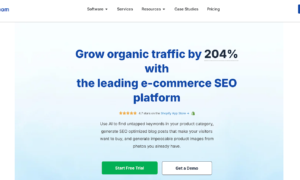Social commerce is a rapidly growing trend in the e-commerce landscape, revolutionizing the way consumers shop and businesses sell. With the rise of social media, businesses have been able to tap into the power of social networks to reach and engage with their target audiences in new and innovative ways. In this blog post, we’ll take a comprehensive look at what social commerce is, how it works, and why it’s important. We’ll also examine several key trends that are shaping the e-commerce landscape in the social media age.
What is Social Commerce?
Social commerce refers to the integration of social media and e-commerce, allowing businesses to sell products and services directly to consumers through social media platforms. It leverages the power of social networks to drive sales and increase brand visibility, creating new opportunities for businesses to reach and engage with their target audiences.
It typically involves the use of social media platforms, such as Facebook, Instagram, TikTok, and others, to promote and sell products and services. Businesses can create product pages or catalogs on social media, allowing consumers to browse and purchase products directly from the platform. Additionally, social selling often incorporates features such as user-generated content, social media influencer marketing, and live-stream shopping to create engaging and interactive shopping experiences for consumers.
Benefits of Social Commerce for Businesses and Consumers
There are numerous benefits of social commerce for both businesses and consumers. Here are just a few of the advantages that it can provide:
Benefits of Social Commerce for Businesses
- Increased Reach and Visibility – Social commerce allows businesses to reach and engage with a wider audience through social media platforms, increasing brand visibility and reach.
- Cost-Effective Marketing – Social selling provides a cost-effective way for businesses to reach and engage with their target audience, as promoting products and services through social media can often be less expensive than traditional advertising methods.
- Data and Insights – This provides businesses with valuable data and insights into consumer behavior, allowing them to make informed decisions and improve their overall marketing strategy.
- Improved Customer Engagement – It allows to interact with and engage with their target audience in new and innovative ways, improving customer engagement and building stronger relationships.
- Increased Sales – By reaching and engaging with a wider audience through social media platforms, businesses can drive sales and increase revenue.
Benefits of Social Commerce for Consumers
- Convenient and Personalized Shopping Experience – Social commerce allows consumers to browse and purchase products directly from social media platforms, providing a convenient and personalized shopping experience.
- User-Generated Content – It often incorporates user-generated content, such as customer reviews, which allows consumers to make informed purchasing decisions based on the experiences of others.
- Interactivity and Engagement – Social selling offers consumers a more interactive and engaging shopping journey, as they are able to connect with brands and other customers through new and creative means.
- Accessible Products and Services – Shopping through social media allows consumers to gain easier access to a wider range of products and services, without having to leave the platform.
- Transparent and Trustworthy Purchasing – It enhances transparency and trust in the buying process, as consumers are able to view customer reviews and other forms of user-generated content to make informed decisions.
Social Commerce Trends in the Social Media Age
The rise of social media has had a profound impact on the e-commerce landscape, leading to several key trends in social commerce. In this section, we’ll examine several of these trends and how they are shaping the future of e-commerce.
Social Media Shopping
Social media shopping is a form of social commerce that allows consumers to browse and purchase products directly from social media platforms. This trend has been driven by the increased integration of social media and e-commerce, as well as the growing popularity of mobile shopping.
Social Media Influencer Marketing
Social media influencer marketing is another trend in social commerce that is growing in popularity. This marketing strategy involves partnering with social media influencers to promote products and services to their followers. Social media influencer marketing can be an effective way for businesses to reach and engage with their target audiences, driving sales and increasing brand visibility.
Rise of Mobile Shopping
Mobile shopping is another trend in social commerce that is on the rise. With the increasing popularity of smartphones and mobile devices, more and more consumers are using their devices to shop online. This has led to the development of mobile-first e-commerce strategies, designed to provide consumers with a convenient and personalized shopping experience on their mobile devices.
Growth of User-Generated Content
This type of content, created by consumers themselves, can include product reviews, social media posts, and other types of content related to products and services.
Customer reviews are a key form of user-generated content in the e-commerce landscape, providing valuable insights into the experiences of other consumers. Customer reviews can help businesses identify areas for improvement, as well as provide valuable marketing insights. Additionally, customer reviews can also help build trust with potential customers, as they provide a more authentic and trustworthy perspective on products and services.
In addition to providing valuable insights, user-generated content can also be used as a marketing tool. For example, businesses can feature customer reviews on their e-commerce websites and social media platforms, using them to promote their products and services to potential customers. Additionally, businesses can also leverage user-generated content to create more engaging and interactive shopping experiences for consumers.
Emergence of Virtual and Augmented Reality
Virtual and augmented reality are two cutting-edge technologies that are beginning to make an impact in the world of social commerce. These technologies provide new and innovative ways for businesses to engage with their target audiences, creating more immersive and interactive shopping experiences for consumers.
Businesses that want to stay ahead of the curve in the e-commerce landscape should consider incorporating social selling into their overall marketing strategy. By leveraging the power of social media to reach and engage with their target audiences, businesses can drive sales, increase brand visibility, and provide consumers with a convenient and personalized shopping experience.
So, if you’re looking to stay ahead of the curve in the e-commerce landscape, now is the time to start exploring the world of social commerce. Whether you’re a small business just starting out, or a large enterprise looking to expand your reach, social selling offers a wealth of opportunities for businesses of all sizes.



































